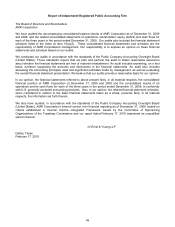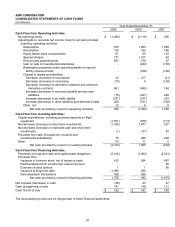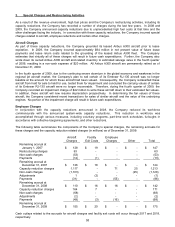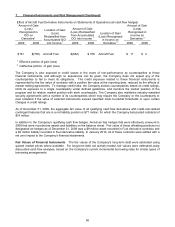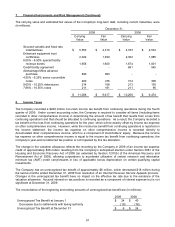American Airlines 2009 Annual Report Download - page 60
Download and view the complete annual report
Please find page 60 of the 2009 American Airlines annual report below. You can navigate through the pages in the report by either clicking on the pages listed below, or by using the keyword search tool below to find specific information within the annual report.
57
1. Summary of Accounting Policies (Continued)
Equipment and property under capital leases are amortized over the term of the leases or, in the case of certain
aircraft, over their expected useful lives. Lease terms vary but are generally ten to 25 years for aircraft and seven
to 40 years for other leased equipment and property.
Regional Affiliates Revenue from ticket sales is generally recognized when service is provided. Regional
Affiliates revenues for flights connecting to American flights are based on industry standard proration agreements.
Passenger Revenue Passenger ticket sales are initially recorded as a component of Air traffic liability.
Revenue derived from ticket sales is recognized at the time service is provided. However, due to various factors,
including the complex pricing structure and interline agreements throughout the industry, certain amounts are
recognized in revenue using estimates regarding both the timing of the revenue recognition and the amount of
revenue to be recognized, including breakage. These estimates are generally based upon the evaluation of
historical trends, including the use of regression analysis and other methods to model the outcome of future
events based on the Company’s historical experience, and are recorded at the scheduled time of departure.
Various taxes and fees assessed on the sale of tickets to end customers are collected by the Company as an
agent and remitted to taxing authorities. These taxes and fees have been presented on a net basis in the
accompanying consolidated statement of operations and recorded as a liability until remitted to the appropriate
taxing authority.
Frequent Flyer Program The estimated incremental cost of providing free travel awards is accrued for mileage
credits earned by using American’s service that are expected to be redeemed in the future. American also
accrues a frequent flyer liability for the mileage credits that are expected to be used for travel on participating
airlines based on historical usage patterns and contractual rates. American sells mileage credits and related
services to companies participating in its frequent flyer program. The portion of the revenue related to the sale of
mileage credits, representing the revenue for air transportation sold, is valued at fair value and is deferred and
amortized over 28 months, which approximates the expected period over which the mileage credits are used.
Breakage of sold miles is recognized over the estimated period of usage. The remaining portion of the revenue,
representing the marketing services sold and administrative costs associated with operating the AAdvantage
program, is recognized upon sale as a component of Other revenues, as the related services have been provided.
The Company’s total liability for future AAdvantage award redemptions for free, discounted or upgraded travel on
American, American Eagle or participating airlines as well as unrecognized revenue from selling AAdvantage
miles was approximately $1.5 billion (and is recorded as a component of Air traffic liability on the accompanying
consolidated balance sheets) at December 31, 2009 and $1.7 billion as of December 31, 2008.
Income Taxes The Company generally believes that the positions taken on previously filed income tax returns
are more likely than not to be sustained by the taxing authorities. The Company has recorded income tax and
related interest liabilities where the Company believes its position may not be sustained or where the full income
tax benefit will not be recognized. Thus, the effects of potential income tax benefits resulting from the Company’s
unrecognized tax positions are not reflected in the tax balances of the financial statements. Recognized and
unrecognized tax positions are reviewed and adjusted as events occur that affect the Company’s judgment about
the recognizability of income tax benefits, such as lapsing of applicable statutes of limitations, conclusion of tax
audits, release of administrative guidance, or rendering of a court decision affecting a particular tax position.
Advertising Costs The Company expenses on a straight-line basis the costs of advertising as incurred
throughout the year. Advertising expense was $153 million, $153 million and $162 million for the years ended
December 31, 2009, 2008 and 2007, respectively.
Subsequent Events In connection with preparation of the consolidated financial statements and in accordance
with the recently issued guidance by the FASB, the Company evaluated subsequent events after the balance
sheet date of December 31, 2009 through February 17, 2010.




